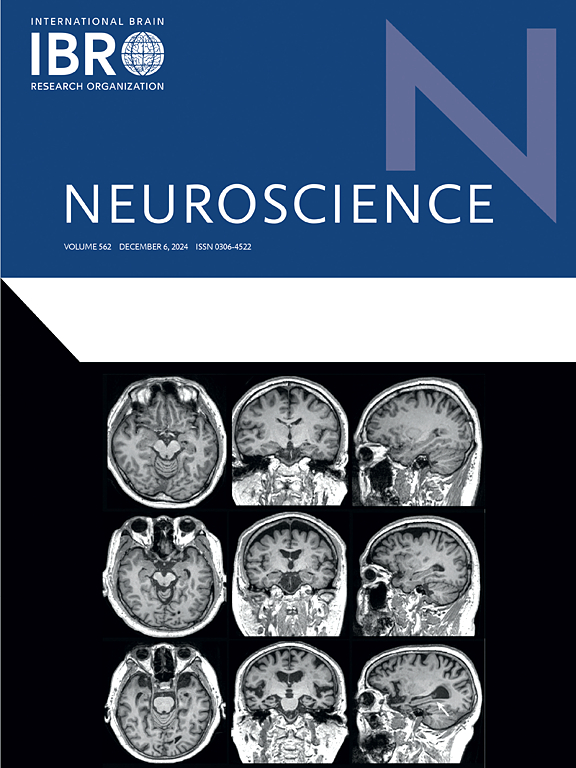低强度经颅超声刺激对异丙酚麻醉小鼠神经血管耦合的调节作用。
IF 2.9
3区 医学
Q2 NEUROSCIENCES
引用次数: 0
摘要
背景:已有研究报道低强度经颅超声刺激(LI-TUS)可以调节麻醉苏醒。麻醉过程中神经血管耦合的动态变化持续协调空间脑血流。LI-TUS如何调节神经血管耦合以改变麻醉需要阐明。方法:16只健康BALB/c小鼠分为经颅超声刺激(TUS)组(n = 8)和Sham组(n = 8)。手术后,小鼠腹腔注射异丙酚。TUS组小鼠经颅超声刺激。记录脑电图、皮层脑血管图像和肌电图。利用光学本征信号成像和电生理采集技术分析了这些指标的变化。结果:我们发现LI-TUS缩短了TUS组的苏醒时间。此外,TUS组观察到以下变化:(1)麻醉恢复期脑血管脱氧血红蛋白在TUS-10 min、TUS-15 min和TUS-20 min的相对变化减小;(2)在深度麻醉阶段,[4-8 Hz]、[8-13 Hz]、[13-30 Hz]和[30-60 Hz]频段局部场电位平均绝对功率的相对变化增大。此外,TUS组在[60-90 Hz]频带平均绝对功率相对变化与脑血管脱氧血红蛋白相对变化之间的Pearson相关系数较小。结论:LI-TUS缩短了异丙酚麻醉小鼠的苏醒时间,这可能是由于LI-TUS激活了神经活动,增加了脑血流量,改善了脑血氧合和神经血管耦合。本文章由计算机程序翻译,如有差异,请以英文原文为准。

Low-intensity transcranial ultrasound stimulation modulates neurovascular coupling in mice under propofol anesthesia
Background
Studies have reported that low-intensity transcranial ultrasound stimulation (LI-TUS) can modulate the emergence from anesthesia. Dynamic changes in neurovascular coupling during anesthesia continuously coordinate spatial cerebral blood flow. How LI-TUS modulates neurovascular coupling to alter anesthesia need to be elucidated.
Methods
Sixteen healthy BALB/c mice were divided into the transcranial ultrasound stimulation (TUS) group (n = 8) and the Sham group (n = 8). After a surgical procedure, mice were intraperitoneally injected with propofol. Mice in the TUS group were stimulated by transcranial ultrasound. Electroencephalogram, cerebrovascular images of the cortex, and electromyography were recorded. The changes of these indicators were analyzed using optical intrinsic signal imaging and electrophysiological acquisition.
Results
We found that LI-TUS shortened the awakening time in the TUS group. Furthermore, the following changes in the TUS group were observed: (1) During the period of recovery from anesthesia, the relative change in cerebrovascular deoxyhemoglobin was decreased at TUS-10 min, TUS-15 min and TUS-20 min; (2) During the deep anesthesia phase, the relative change of mean absolute power of local field potentials was increased at [4–8 Hz], [8–13 Hz], [13–30 Hz], and [30–60 Hz] frequency bands. Furthermore, the Pearson correlation coefficients between the relative change of mean absolute power at [60–90 Hz] frequency band and the relative change in cerebrovascular deoxyhemoglobin were smaller in the TUS group.
Conclusion
LI-TUS shorten the time of awakening in mice under propofol anesthesia, which may due to LI-TUS energized the neural activity, increased cerebral blood flow, improved the cerebral blood oxygenation and neurovascular coupling.
求助全文
通过发布文献求助,成功后即可免费获取论文全文。
去求助
来源期刊

Neuroscience
医学-神经科学
CiteScore
6.20
自引率
0.00%
发文量
394
审稿时长
52 days
期刊介绍:
Neuroscience publishes papers describing the results of original research on any aspect of the scientific study of the nervous system. Any paper, however short, will be considered for publication provided that it reports significant, new and carefully confirmed findings with full experimental details.
 求助内容:
求助内容: 应助结果提醒方式:
应助结果提醒方式:


